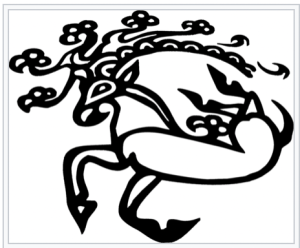In The Scot & the Sorceress, Nyssa has blue marks on her skin. What are they? They sound like they might be tattoos, but I never call them that.
The word “tattoo” is much more recent than the Middle Ages. There are several different attributions, but let’s go with the most popular: that it comes from the Samoan word ‘tatau’, meaning ‘to strike’—because a tool was struck against the skin to make the holes that would subsequently be filled with color. The word is not noted in English until the 18th century, introduced after Captain Cook’s travels to the south Pacific—where he noted the beautiful art adorning people’s bodies in Tahiti. His account of his voyage is the first use of the word in an English source.
The art of marking the skin, though, goes back much further than this. The oldest figurative tattoos were found in 2018 on the bodies of two mummies from Ancient Egypt, dated between 3351 and 3017 BCE. I couldn’t find any pictures of them, but there are many images online of Otzi, a mummified corpse discovered in the Alps with over 60 tattoos, dated to 3250 BCE. Here’s an article at the Smithsonian showing Otzi’s tattoos and telling more about him.
My favorite ancient tattoos are those of the Princess of Ukok, a woman discovered in Siberia and sometimes called the Siberian Ice Maiden. She was buried in the 5th century BC and discovered in 1993 – she was of the Pazyryk tribe, who lives on the Eurasian Steppe, and was buried in what is now the autonomous Republic of Altai. She was between 20 and 30 years of age, and was buried with six horses, an elaborate headdress, ornaments and offerings, indications that she was a priestess and/or shaman. She had gorgeous tattoos. You can read the Wiki about her here.

A second tomb was found in the same vicinity for a man who also had beautiful tattoos. This article is about both of them but the first illustration shows the man’s tattoos. Scroll down to see her tattoos. The most remarkable one, for me, is the creature on her left shoulder. Here’s a drawing of it from Wiki.
There are many other peoples who have marked their skin in the past five thousand years, but we’ll look finally at the Picts, who resided in the area Fortrui—now Inverness and Moray—before the 8th century. We don’t know what they called themselves, but the Romans called them Picti from the 3rd century, which means ‘painted ones’. Some interpret this as meaning that the Picts tattooed themselves; others suggested that they painted their bodies. Blue is a common color associated with this ornamentation.
For the imagery of Nyssa’s tattoos, I took inspiration from the many carved stones created by the Picts. Although these peoples left no written records, they did leave a number of these stones, and there are common elements in their imagery. (The Aberlemno I stone is a good example.) These include serpents, the double disk and Z-rod (you can see one of these on a silver plaque in the Norrie’s Law Hoard), the mirror and comb, the so-called Pictish Beast, and insular interlace similar to what we see in other Celtic images and depictions of animals. The St. Ninian’s Isle treasure is considered the best collection of Pictish items and includes many ornamental penannular silver broaches. I chose a serpent for one of her tattoos, although there are many many possibilities here.
How did ancient people make tattoos? Presumably, they also pierced the skin then rubbed pigment into the holes. What did they use for color? It’s possible that they used woad, a blue dye derived from the plant Isatis tinctoria which was a popular dye for cloth in the Middle Ages. (Although indigo has been known as a blue dye for millennia, it was rare in Europe in the Middle Ages, as it had to be imported from much warmer climates.)
Nyssa’s tattoos are a fictional invention of my own, but they’re not that implausible. It only makes sense to me that such marks would be indicative of achievements for a seer or shaman, but that too, is part of my fictional world of The Scot & the Sorceress.


